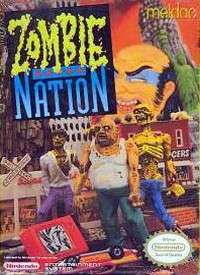Zombie Nation (video game)
| Samurai Zombie Nation Abarenbō Tengu | |
|---|---|
 Cover art for the North American release for the NES | |
| Developer(s) | KAZe |
| Publisher(s) | Meldac / Liveplanning |
| Director(s) | Norio Nakagata |
| Producer(s) |
Sueo Sekizawa (executive producer) Junichiro Kawazoe |
| Designer(s) | Takane Ohkubo |
| Programmer(s) | Kunihiro Hiramatsu |
| Artist(s) |
Shin-ichi Ogawa Takao Yoshiba |
| Composer(s) |
Takane Ohkubo Norio Nakagata |
| Platform(s) | Nintendo Entertainment System |
| Release date(s) | |
| Genre(s) | Shoot 'em up |
| Mode(s) | Single-player |
Samurai Zombie Nation, as the in-game title screen calls it, is a 1990 NES action game developed by KAZe and published by Meldac. It was first released in Japan in December 14, 1990 under the title Abarenbou Tengu (暴れん坊天狗 Abarenbō Tengu, lit. "Hooligan Tengu"), before being released later in the United States on January 1991. This game features a juxtaposition of zombies and samurai.
In Samurai Zombie Nation, the floating samurai head Namakubi goes to the United States to destroy Darc Seed — an alien who crashed to Earth via a meteorite in 1999, turned all the American people into zombies, and took control of various deadly weapons. Namakubi must recover the samurai sword Shura and destroy Darc Seed and its minions.
Gameplay
Depending on the version of the game, the player controls the giant levitating disembodied samurai head Namakubi (生首 namakubi, lit. "freshly severed head") or a giant Tengu mask. The player can destroy structures and enemies by shooting rapid-fire eyeballs and vomit at them.[1] Enemies include zombie snipers, zeppelins and lava monsters.[2] The player can upgrade his/her firepower by rescuing zombie hostages that leap out of structures when destroyed.[3]
The player starts every level with a full life bar of eight units (displayed as mini Namakubi heads on the bottom of the screen), and as the player gets hit, the life bar decreases. When it is down to one bar remaining, the music changes to a dramatic theme. The game ends when the player loses all eight units on his/her life bar or is crushed by the scrolling of the screen. However, the player can regenerate some of his/her life by defeating enemies and structures. In addition, the player gets six (increasing by one for every stage section completed, up to a maximum of nine) continues to beat the game.[4]
Zombie Nation features two difficulty levels — easy and hard. It also allows the player, like in the Mega Man series, to select any stage at will. Once a stage is selected the following stages will be played sequentially cycling from stage 4 back to 1. The objective is to clear all four stages and then destroy the final boss, Darc Seed.[5]
Story
The plot of both Zombie Nation and Abarenbou Tengu takes place in 1999, when a meteor known as "Darc Seed" (Eva in the Japanese version) crashes in the Nevada desert. Darc Seed/Eva then shoots magnetic rays and turns the people of the United States into zombies. Darc Seed/Eva also brings the Statue of Liberty to life to follow its commands. The magnetic rays also allows Darc Seed/Eva to control many deadly weapons, including the most powerful weapon of all — the legendary samurai sword Shura.
The head of the samurai Namakubi hears of Shura falling into Darc Seed's clutches. He then heads to the United States to destroy Darc Seed, free the American people from the looming zombification and reclaim the samurai sword Shura.[6]
Development and release

The game is first released in Japan under the name Abarenbou Tengu on December 14, 1990. The US version is released a month later. As both versions only has differences between the sprites, with the Japanese version having a tengu mask belonging to Japanese folklore. The US version has major graphical and story changes, replacing the tengu mask with the decapitated samurai head.[7] Aside from the differences, both games are practically identical, with the Japanese Version having only a few major differences:
- In Abarenbou Tengu, the player must obtain the rapid fire ability. In Zombie Nation, the player starts with it.
- The main character's sprite is not that of the flying samurai head, Namakubi, but that of a Japanese konoha tengu head. The title screen is different with the tengu's head being incorporated into it.
- The boss of Round I is an evil Statue of Liberty in both games but with a slightly different sprite; instead of being green with snakes in place of its crown in Zombie Nation, it's red and has a normal crown.
Reception
The US release of the game was reviewed in 1991 in Dragon #172 by Hartley, Patricia, and Kirk Lesser in "The Role of Computers" column. The reviewers gave the game 2½ out of 5 stars.[8] The Japanese version is however criticized due to its difficulty and gameplay, and considered a kuso-gē (クソゲー, lit. "crap game"). However, both versions of the game are considered a cult hit among gamers.
Notes
- ↑ Instruction Manual, How to Use the Controller.
- ↑ Instruction Manual, Enemy Characters.
- ↑ Instruction Manual, Game Description.
- ↑ Instruction Manual, The Life Gauge.
- ↑ Instruction Manual, How to Play the Game.
- ↑ Instruction Manual, Introduction.
- ↑ GameCenter CX Episode 67, Fuji TV. AD Nakayama explains about the changes in both versions of the Game.
- ↑ Lesser, Hartley; Lesser, Patricia & Lesser, Kirk (August 1991). "The Role of Computers". Dragon (172): 55–64.
References
- "Zombie Nation Instruction Manual". Meldac. 1990. NES-51-USA. Retrieved 2008-06-08.